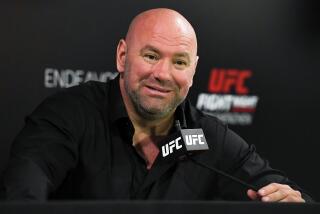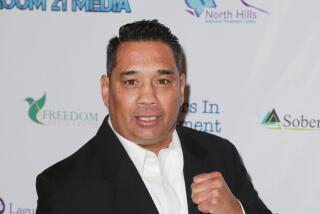Boxer to Fight in Montana Despite Past Eye Problems
- Share via
Marvin Camel, who twice won world cruiserweight boxing championships after having been declared medically unfit to box in California, is making a comeback at 37.
A decade ago, Camel was told that he was risking his sight in one eye by continuing to box, but Thursday night, in Great Falls, Mont., he is scheduled to fight an eight-round bout.
For the record:
12:00 a.m. Aug. 26, 1989 Los Angeles Times Saturday August 26, 1989 Home Edition Sports Part 3 Page 12 Column 1 Sports Desk 2 inches; 41 words Type of Material: Correction
For the record: Matthew Bernstein, the Los Angeles ophthalmologist who discovered that boxer Marvin Camel had a detached retina in the late 1970s, did not submit a false medical report on Camel’s condition, as indicated in a Times story earlier this month, but rather submitted no report at all.
There doesn’t figure to be any announcement in Montana that Camel was once told in Los Angeles he would never be permitted to box again in California.
A Los Angeles ophthalmologist who examined Camel before a fight in Los Angeles in the late 1970s said Monday that he discovered a detached retina in Camel’s right eye during a prefight eye exam. Eye exams are required in California of first-time boxers before a boxing license can be issued.
The ophthalmologist, Matthew Bernstein, said he at first wanted to submit his findings to the California Athletic Commission, but decided instead to call the injury corneal abrasions. Bernstein said that he “acted against his better instincts” in the Camel case and it was a decision he has since regretted.
“I felt sorry for the poor guy,” he said. “I remember he came into my office wearing his championship belt. And he was terribly disappointed he wouldn’t get that $200,000 payday.”
Bernstein recalled that the fighter’s manager became angry when Bernstein told him he would report Camel’s detached retina.
“Camel’s manager went up the wall when I told him what I intended to do,” Bernstein said.
“He told me such a report would mean Camel couldn’t get fights anywhere, that it would end his career. His payday for the fight in L.A. was $200,000, so he was already putting a guilt trip on me for costing him that.
“I submitted a report saying that (Camel) had corneal abrasions and that they wouldn’t heal in time for that fight. In exchange for that, Camel and his people promised me he would have his retina repaired and that he would never again attempt to box in California.
“I told them that if I ever heard of him trying to get a California license, I would submit a full report on his eye to the commission.”
Bernstein said that Camel had his retina repaired in Los Angeles by another ophthalmologist who gave his approval for Camel to box again.
“That surgeon told me Camel’s retina was stronger than it was the day he was born,” Bernstein said.
“But there is a difference of opinion among ophthalmologists on what the injury risk is to boxers who’ve had retinal surgery,” he said. “All retina surgeries are different, but many surgeons feel that in some cases the injury risk is not greater than it was before the injury.”
Camel, reached at his Butte, Mont., training camp Monday night, said he had had 16 fights since undergoing retinal surgery.
“I was assured by the doctor I was at no greater risk than anyone else,” he said. “Anyone who gets in the ring takes a risk, and so does anyone who gets on the freeway. I love boxing, that’s all.”
Bernstein said he first regretted not identifying Camel as a detached retina case in 1980, while watching the Sugar Ray Leonard-Roberto Duran rematch on television.
“I was watching the undercard bouts with a friend when all of a sudden the camera picks up Camel coming down the aisle, prepared to box,” he said.
“I was shocked and sickened. Here was a guy with plastic material in his eye, from eye surgery. I was afraid the plastic material holding his eye together would fly out right in the middle of the fight. I’ve regretted the way I handled that exam ever since. . . . I’ve never done anything like that, before or since.”
California and New York are the only states that require an eye exam of first-time boxers. And California does not allow those boxers who have had detached retinas to box here. Sugar Ray Leonard, for example, cannot box in California. He cannot even spar. He had 1982 surgery for a detached retina in his left eye.
Last October, State Athletic Commission officers halted a scheduled workout by Leonard at Century City, just as he was about to spar.
Many in boxing would like to see all states conform to the same boxing injury and medical standards. Rep. Pat Williams (D-Mont.) plans to conduct hearings on the subject of federal legislation that would create uniform medical and safety standards for all professional boxing in the United States.
Camel, a native of Missoula, Mont., has lived in Los Angeles the last five years. He has a 42-11-3 record. He became the World Boxing Council’s first cruiserweight champion in 1980 but lost that title the same year. In 1983, he won the International Boxing Federation’s cruiser championship.
Mary Lou Garrett, administrator of the Montana Board of Athletics, was unaware of Camel’s eye surgery history when contacted Monday and said all she had was a 1980 Montana ophthalmology report that cleared Camel to box. She had no immediate comment on whether Camel’s history could affect Thursday’s fight.
More to Read
Go beyond the scoreboard
Get the latest on L.A.'s teams in the daily Sports Report newsletter.
You may occasionally receive promotional content from the Los Angeles Times.










